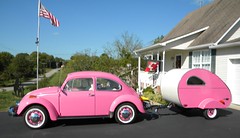I finally moved from graph paper and pencil, to actual parts.
After sitting in cardboard cutouts and feeling my way around, I decided on a 10 ft long, 5 ft high, 56 inch wide. (New beetle diesel tow car set the width.)
Harbor Freight 1700 lb trailer. I did move the axle back and lowered it with an axle flip.
I started out thinking that I wanted sandwich walls, plywood bonded inside and out. (+ fiberglass?)
After many sleepless nights and reading this forum, I decided to go with foam panels and fiberglass.
Plan was 1.5 inch foam, but I found 3 inch, used roofing panels, 4X8, felt covered, with one really clean side. (Back side has minor imperfections.)
The price was right, so I will have R 18 insulation and a slightly smaller interior. I purchased 12 in all, (Looks like I could just glue them all together and hollow out the inside javascript:emoticon(':lol:') )
I am still trying to figure out haw many kerfs per inch on the inside of the curved roof panels to allow a (somewhat) smooth curve on the outside.
Is this just guesswork, and trial and error, or is there a rule of thumb on how much I need to allow the inside to collapse for a given curve?
new build started,3 inch POLYISOCYANURATE foam walls
3 posts
• Page 1 of 1
